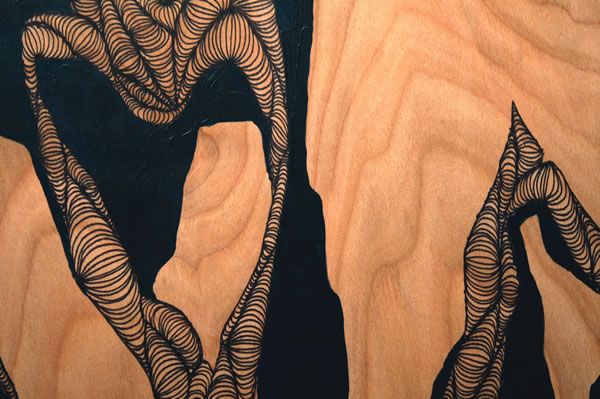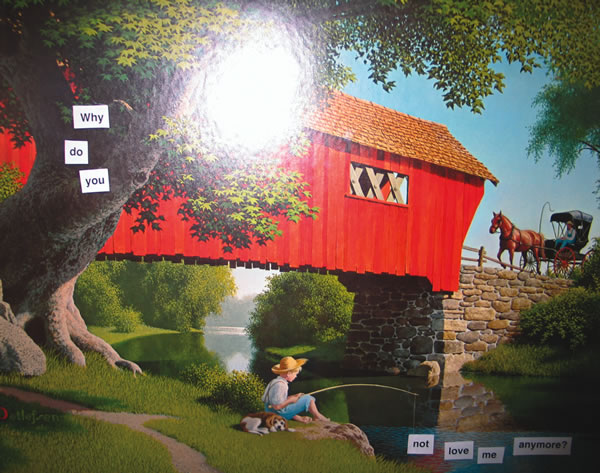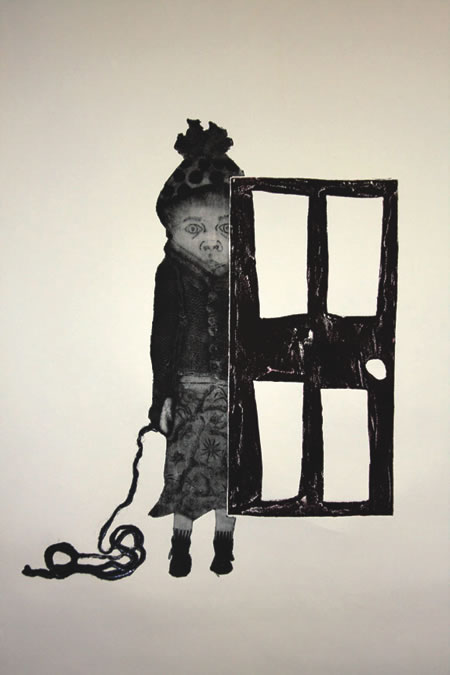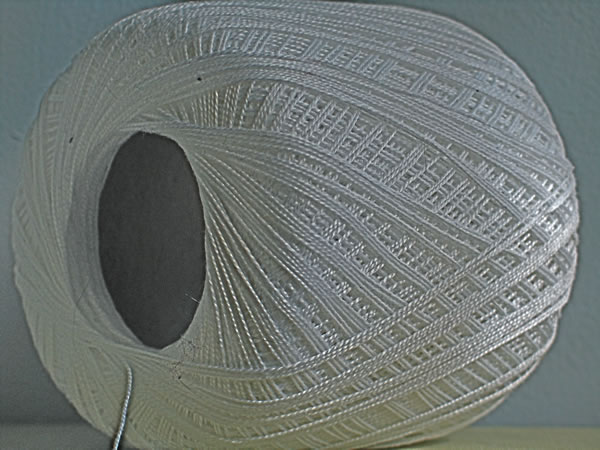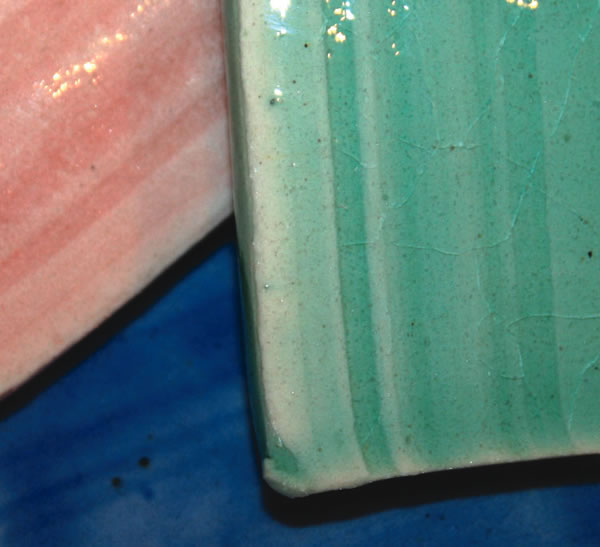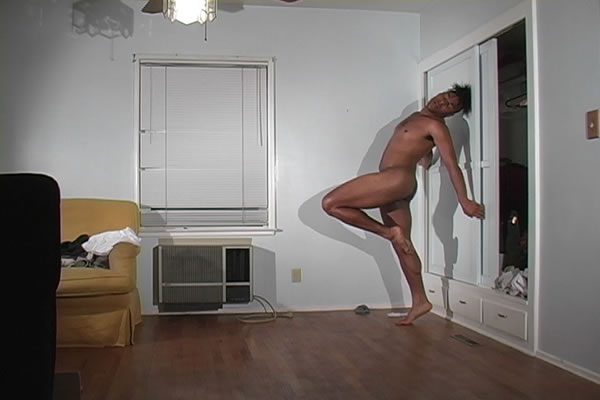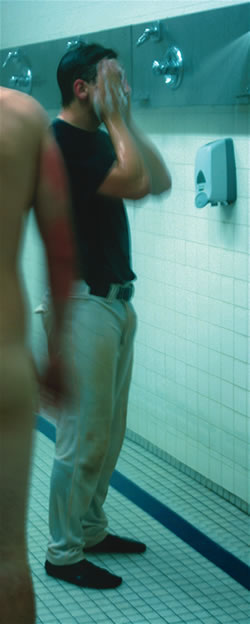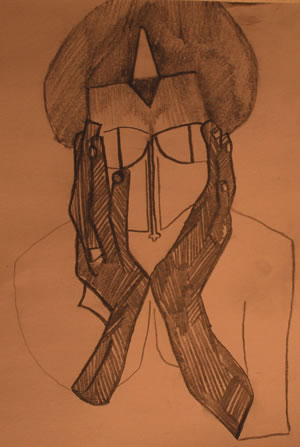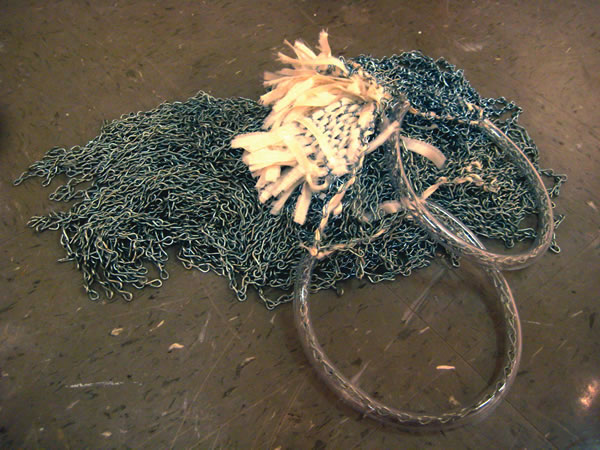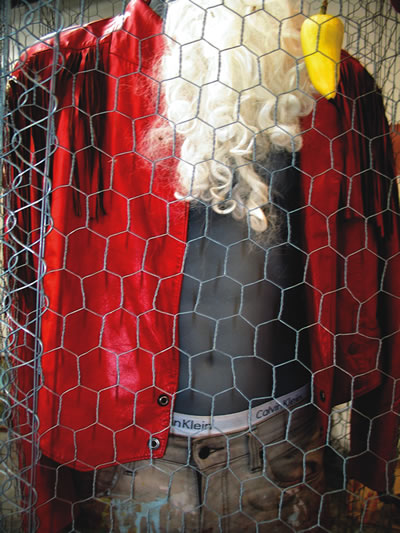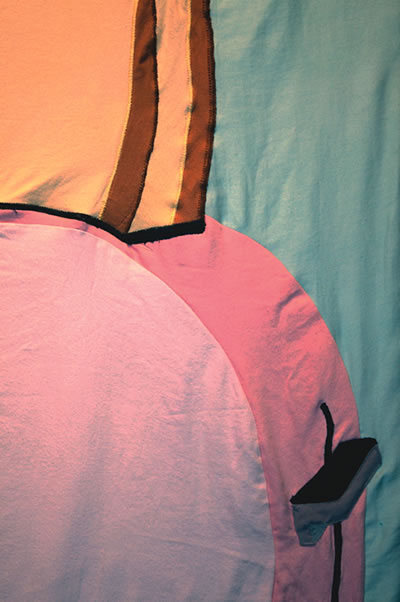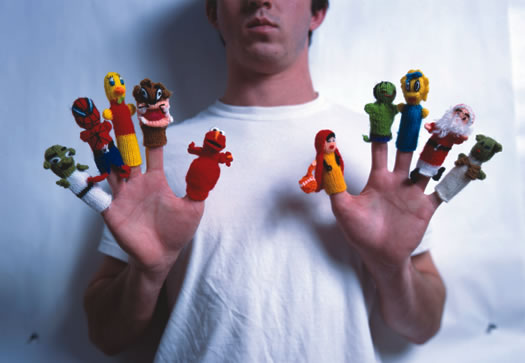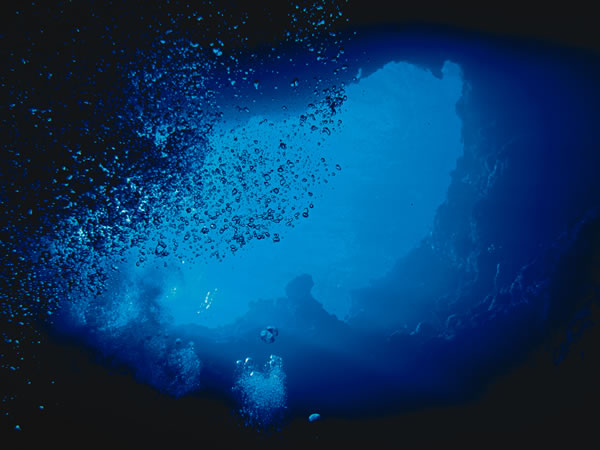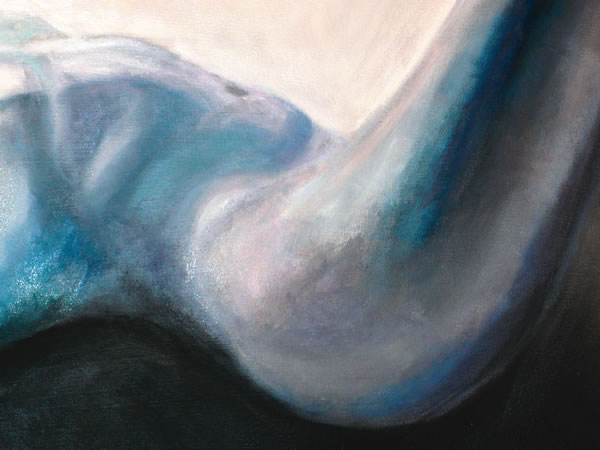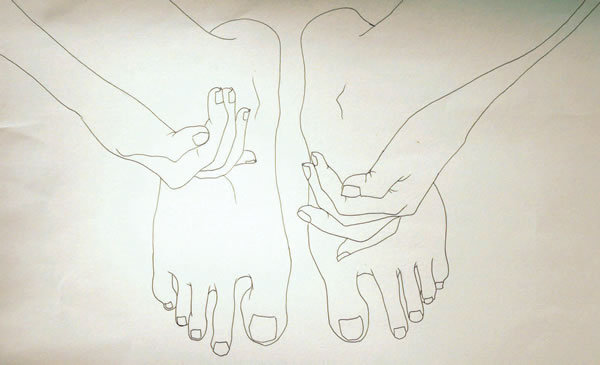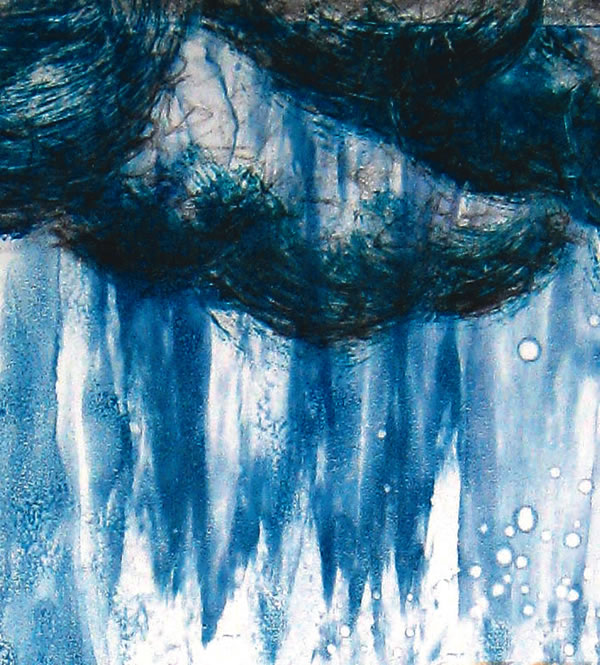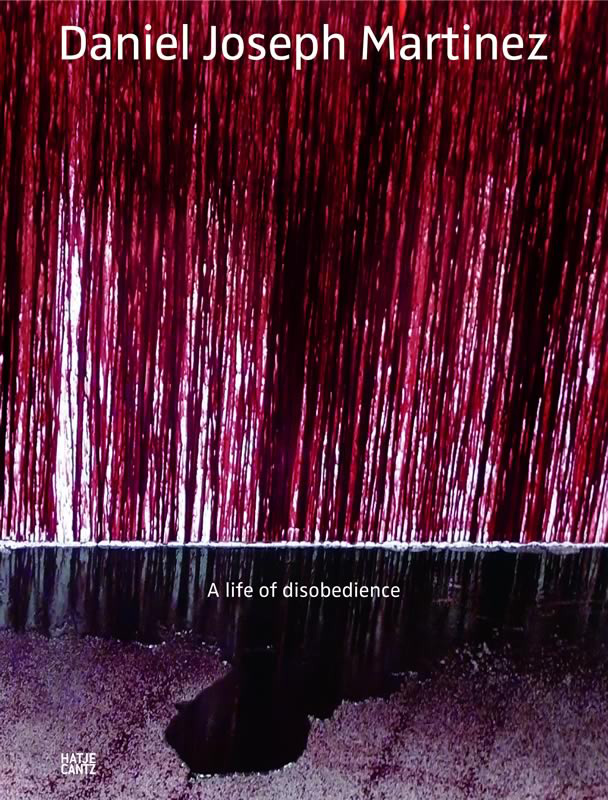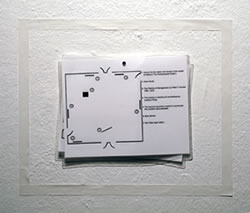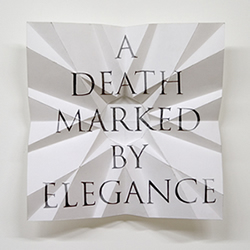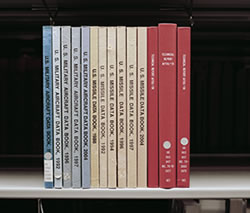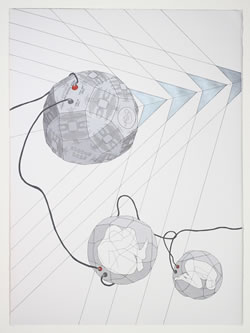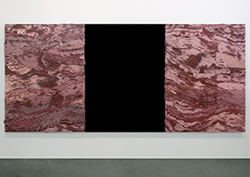September 24 — December 11, 2009
Nichols Gallery, Pitzer Art Galleries
Rheim Alkadhi, Mathilde ter Heijne, Nadine Hottenrott, Karen Lofgren, Shana Lutker, Jeni Spota, Carrie Yury and Joy Whalen
Veronica draws together an all-woman cast of artists from the United States, Germany and The Netherlands whose works involve an examination of their cultural guideposts. Inspired by the myth of Saint Veronica—who mopped Jesus’s brow on the road to Golgotha resulting in an imprint of his face on her veil––the artists attempt to cleanse and update existing stereotypes and the icons that support them. Like Veronica, who committed a brave and selfless act, these artists have created courageous works that tackle gender, politics, religion and identity issues while freely indulging in the familiar tropes and rituals of ancient myth and magic. The result is a collection of visually compelling works that beguile with formal invention and persuade with thematic wit.
Nadine Hottenrott‘s The Cloth (2006-2008,) a white wool bedspread comprised of hundreds of crocheted swastikas, holds the possibility for reinterpretation of a politically charged symbol.
Carrie Yury‘s Suits (2008) zoom in for extreme close-ups of famous power suits worn by female politicians and leading ladies featured in the recent presidential election.
Exploring the idea of strength and its loss, the female protagonist in Joy Whalen‘s video Samson (2008) struggles to free herself from the confines of an austere whitewashed institutional space.
Karen Lofgren investigates the irresistible force of myth and legend in Sleepwalker (2008/2009), a 25-foot meticulously gilded chain.
Shana Lutker explores the idea of belief and authenticity in Veil, no.1 (Veronica,) no.2 (A Deception,) no.3 (Arrested) (2006 – 2009,) a triptych featuring three framed postcards: “The Veil of Veronica,” “Venus Rising From the Sea—A Deception,” and “Arrested for Bribing Basketball Players, New York, 1942.”
Our need for moral fables and allegorical tales is evidenced in Jeni Spota‘s Giotto’s Dream (2009), a series of thickly painted panels inspired by a Giovanni Boccaccio and Pier Paolo Pasolini.
In Women to Go (2005), Dutch artist Mathilde ter Heijne restores identities to hundreds of anonymous women who lived between 1839 and 1920 in a series of postcard portraits with biographies of famous women printed on the reverse.
Rheim Alkadhi explores absence and presence in Living in a Shoe on the Leg of Reason (2009), consisting of an upright, life-sized leg wrapped in heavy vintage canvas, striped like an antique prison uniform with a crude canvas serpent by its side.
Rheim Alkadhi
Rheim Alkadhi received her MFA from the University of California, Irvine in 1999. Her solo exhibitions include: Personal Effects, Deep River, Los Angeles, CA (2002) and Body of Conjoined Movements, Artcore Brewery Annex, Los Angeles, CA (2002). Alkadhi has shown work in numerous group exhibitions and screenings including: Veronica, Pitzer Art Galleries, Pitzer College, CA (2009); Destroyed in Baghdad / Repaired in Cairo, Townhouse Open Studio, Downtown Cairo, Egypt (2009); OÙ? Scènes du Sud, Carré d’Art – Musée d’Art Contemporain de Nîmes, Nîmes, France (2008); House of the Matchmaker, Shatana Open Day, Irbid, Jordan (2008); Happy Days, Bensousan Han, Thessaloniki, Greece (2008); System Error: War is a Force that Gives Us Meaning, Palazzo delle Papesse, Siena, Italy (2007); Eternal Flame: Imagining a Future at the End of the World, Gallery at REDCAT, Los Angeles, CA (2007); 5 Shorts, S1F Gallery, Los Angeles, CA (2007); Border Myths / Border Realities, University Art Museum, Long Beach, CA (2007); Media Arts Festival, Friesland, The Netherlands (2007); When Artists Say We, Artists Space, New York, New York (2006); Draw a Line and Follow It, Los Angeles Contemporary Exhibitions, Los Angeles, CA (2006); Art in the Age of New Technologies, Armenian Center for Contemporary Art, Yerevan, Armenia (2005); In/Visible, Arab American National Museum, Dearborn, MI (2005); A Bottle of Dirty and Other Coastal Tales, New Arts Cinema at Whalers Wharf, Provincetown, MA (2005); Singular Identities, India Habitat Center, New Delhi (2004); Images of Violence / Violence of Images, (Young Artists’ Biennial) Goethe Institute / META Cultural Foundation, Bucharest (2004); For A Stranger, Articultural Gallery, Santa Monica, CA (2004); and Middle East Cinema, Blinding Light Cinema, Vancouver, BC Canada (2003). Alkadi received a California Community Foundation Fellowship (2009) and an Arab Fund for Arts and Culture Grant (2008). She lives and works in Los Angeles, CA and Downtown Cairo.
Nadine Hottenrott
German-born Nadine Hottenrott received her MFA in 2009 from the Sandberg Institute in Amsterdam, The Netherlands. She has exhibited in solo and group exhibitions including: Kunstvlaai, Amsterdam (2008); one; & the other painting, W139/Basement, Amsterdam (2007); Mieke Woestenburg, Galerie Masters, Amsterdam (2006); Pleinmuseum, Lowlands Festival, Amsterdam (2006); Amsterdam Experience Filmfestival, Amsterdam (2006); GRA Stumble, Foam, Amsterdam (2005); He Took It To Do, Pakt, Amsterdam (2005). Nadine Hottenrott lives and works in Amsterdam, The Netherlands.
Karen Lofgren
Karen Lofgren was born in Toronto, Canada and received her MFA from California Institute of the Arts in 2000. Her solo exhibitions include: Gold Flood, Pitzer Art Galleries, Pitzer College, CA (2009); and Believer, Machine Project, Los Angeles, CA (1998). She has exhibited in many group exhibitions including, Cocktail Hour with Skip Arnold and Friends, Bonelli Contemporary, Los Angeles (2008); A Field Guide to LACMA, Los Angeles County Museum of Art, Los Angeles, CA (2008); Slab at the Old L.A. Zoo, Los Angeles, CA (2008); At the Middle of Nowhere, Five Thirty Three, Los Angeles, CA (2008); Street Signs and Solar Ovens: Socialcraft in Los Angeles, Craft and Folk Art Museum, Los Angeles, CA (2006); Carter, Kate Davis, Karen Lofgren, Torbjorn Vejvi, Ann Helwing Gallery, Los Angeles, CA (2006); S.E.L.F., Daniel Hug Gallery, Los Angeles, CA (2005); star left, Los Angeles Contemporary Exhibitions, Los Angeles, CA (2005); and High Desert Test Sites#4, Joshua Tree, CA (2004). Lofgren received the following awards: Creation / Production Award to Emerging Artists, Canada Council for the Arts (2003); Cal Arts Dean’s Grant (2000); and a residency at Pitzer College, CA (2009). She lives and works in Los Angeles, CA.
Shana Lutker
Shana Lutker was born in 1978 in Northport, NY. She received her MFA from the University of California Los Angeles in 2005. Her numerous solo exhibitions include: Forever Will a Blockhead Be, Wetterling Gallery, Stockholm, Sweden (2009); The Commiffioners, Susanne Vielmetter Los Angeles, CA (2008); CCA Wattis Institute, San Francisco, CA (2007); and The Future of an Illusion, Room Gallery, University of California Irvine (2007). She has exhibited in many group exhibitions including: On the Pleasure of Hating, Lisa Cooley Gallery, New York, NY (2009); Bitch is the New Black, Honor Fraser, Los Angeles, CA (2009); Broken English, Seiler + Mosseri-Marlio Galerie, Zurich, Switzerland (2009); This is Killing Me, Massachusetts Museum of Contemporary Art, West Adams, MA (2009); Put On, Circus Gallery, Los Angeles, CA (2009); California Biennial, Orange County Museum of Art, Long Beach, CA (2008); Delusionarium 4, David Salow Gallery and Bonelli Contemporary, Los Angeles, CA (2008); The Whole World is Watching, Curated by Irene Tsatsos, Glendale College Gallery, Glendale, CA (2008); November Again, Harris Lieberman, New York, NY (2008); The Silence of Infinite Space, Curated by Aram Moshayedi, Glendale College Gallery, Glendale, CA (2008); Art Perform, Curated by Jens Hoffman, Art Basel, Miami Beach (2007); People for a Better Tomorrow, Curated by Meg Cranston, Sweeney Art Gallery, University of California Riverside, CA (2006);
Re-make/Re-Model, D’Amelio Terras, New York, NY (2006); Happenstance, Curated by Lauri Firstenberg, Harris Lieberman Gallery, New York (2005); Champion Fine Art 2003-2005, Art 2102, Los Angeles, CA (2005); Public Sculpture for Benevento Citta Spettacolo, Theater Festival, September 2005, Curated by Demetrio Paparoni, Italy (2005); and Erzähl mal was, Kunstverein Langenhagen, Langenhagan, Germany (2005). Lutker received the following awards and grants: Emerging Artist Fellowship, California Community Foundation (2008); Artist Completion Grant, Durfee Foundation (2006); Elaine Krown Klein Award, University of California Los Angeles (2004); and a Hoyt Fellowship, MIT (2004). She currently lives and works in Los Angeles, CA.
Jeni Spota
New York-born Jeni Spota received her MFA in 2007 from the School of the Art Institute of Chicago. Her solo exhibitions include: Don’t Tread on Me, Santa Monica Museum of Art, Santa Monica, CA (2009); Tra La La, Greener Pastures, Toronto, Canada (2009); Giotto’s Dream, Museum of Contemporary Art, Chicago, IL (2008); and Giotto’s Dream, Sister, Los Angeles, CA (2007). She has participated in numerous group exhibitions including, Constellations: Paintings from the MCA Collection, Museum of Contemporary Art, Chicago, IL (2009); (N)icholas (F)rank (S)elects: Drawings from the Hermetic Collection, The Green Gallery, Milwaukee, WI (2009); LA Now, Las Vegas Museum, Las Vegas, NV (2008); The Dark Fair, The General Store, New York, NY (2008); and Fifths, SWINGER, Vienna, Austria (2007). Spota’s awards include an ARC Grant, The Durfree Foundation (2009); School of the Art Institute of Chicago Fellowship (2007); National Museum for Women in the Arts Fellowship (2006); and an Ellen Battell Stoeckel Fellowship (2004). Spota currently lives and works in Los Angeles, CA.
Mathilde ter Heijne
Mathilde ter Heijne was born in 1969 in Strasbourg, France. She attended the Stadsacademie in Maastricht, Netherlands and the Rijksacademie in Amsterdam, Netherlands. Her solo exhibitions include: Red, Black, Silver, Arndt & Partner, Berlin, Germany (2009); Susanne Vielmetter Los Angeles Projects, Los Angeles, CA (2007); Mosuo Fireplace Goddess, Currents, Beijing (2007); No Depression in Heaven, Galerie Arndt & Partner, Berlin (2006); Armory Show, New York, Susanne Vielmetter Los Angeles Projects (2006); Suicide Bomb, Susanne Vielmetter Los Angeles Projects, Culver City, CA (2005); Fuck Patriarchy, Viafarini, Milano (2004); Mathilde ter Heijne, Kunstverein, Hannover (2004); Qo akti?, Galerie Martina Detterer, Frankfurt am Main (2003); Small Things End, Great Things Endure, Art Unlimited auf der Art Basel (2002); 98 00, Galerie de Expeditie, Amsterdam (2000); and Suicide Bomb, Förderkoje Art Cologne 2000, Köln (2000). Ter Heijne has also participated in numerous group exhibitions including: Rebelle. Art and Feminism 1969-2009, Museum Moderne Kunst Arnhem, Netherlands (2009); Small Things End, Great Things Endure, New Langton Arts, San Francisco, CA (2008); Walls in the Street, collaboration between Siemens Art Programm, Münich, and Museum of Contemporary Art (MSUB), Belgrade, Serbia (2008); Talking Pictures – Theatralität in zeitgenössischen Film – und Videoarbeiten, K21, Duesseldorf, Germany (2007); Body Double, Luckman Gallery, California State University Los Angeles, Los Angeles, CA curated by Julie Joyce (2007); Made in Germany, Sprengel Museum, Hannover (2007); Shanghai Biennial, Museum of Modern Art, Shanghai (2006); Seoul International Media Art Biennial, Museum of Contemporary Art, Seoul (2006); Ruby Satellite, Hyde Park Art Center, Chicago, curated by Ciara Ennis (2006); This Not a Love Song, Susanne Vielmetter Los Angeles Projects (2006); Romantic Conceptualism, American Federation of Arts, New York (curated by Jörg Heiser) (2006); Urban Creatures, Pori Art Museum, Pori, Finnland (2006); Ruby Satellite, California Museum of Photography, San Francisco (2006); Cut, Susanne Vielmetter Los Angeles Projects, Culver City (2005); and Greater New York, PS1, New York, NY (2005). She was awarded the PS1 Stipend, New York; the Saar-Ferngas-Förderpreis Junge Kunst, Ludwigshafen; the Mama Cash Kunstprijs, Amsterdam; the Arbeitsstipendium Senat Berlin; the Stipendium Podewill, Berlin; the Stipendium Künstlerhaus Bethanien, Berlin; and the Hustinxsprijs, Maastricht. Ter Heijne lives and work in Berlin, Germany.
Joy Whalen
Joy Whalen earned her MFA at the Pratt Institute in New York in 2007. Her numerous solo exhibitions include: Fables of Forfeit, Tropo Mfg., Pomona, CA (2008); What They Found, Flatfile Galleries, Chicago, MI (2007); Sorry I Kicked You, Stuben South Gallery, Brooklyn, NY (2007); and Fairy Tales and Spin, A + D Gallery, Chicago, MI (2005). Whalen has been in numerous group exhibitions including: Bushwick Open Studios, United Kingdom, New York, NY (2009); Anti-Oxidant, United Kingdom, NY (2009); Fire Proof, SHO Gallery, New York, NY (2009); Vitruvian Woman, Formverk Gallery, Nyköping, Sweden (2009); Body Language, a Video Screening, Monkeytown, New York, NY (2008); 122 for $122, PS 122, New York, NY (2008); Building Steam, Grossman Gallery, Easton, PA (2008); It’s Not Easy, Exit Art, New York, NY (2008); Smalls, Burning River Gallery, Brooklyn, NY (2008); Group Therapy, Windows Gallery, New York, NY (2008); Perspicuous: Work on Space and Image, East Hall Gallery, Brooklyn, NY (2007); Re-Structured, Andre Zarre Gallery, New York, NY (2007); and Americana, Soke Fine Art, Denver, CO (2006). Whalen has received several awards and scholarships including, a DAC Grant, Brooklyn Art Council (2008-2009); and an Albert Weisman Memorial Scholarship, Columbia College Permanent Collection (2005). Whalen currently lives and works in Brooklyn, NY.
Carrie Yury
Carrie Yury received her MFA from the University of California Irvine in 2006. Her numerous solo exhibitions include: Room, Sam Lee Gallery, Los Angeles, CA (2009); My Performance Anxiety, Sam Lee Gallery, Los Angeles, CA (2008); Untitled Work, The Office, Huntington Beach, CA (2005); and You are Your Own Best Pin-Up, Swallow Gallery, Chicago, IL (1999). She has also shown in many group exhibitions including: The Audacity of Desperation, The Urbana-Champaign Independent Media Center, PS 122 New York, NY (2008); Photo LA, Jail Gallery, Santa Monica, CA (2008); Ego, Jail Gallery, Los Angeles, CA (2007); E-Ticket Ride, J. Flynn Gallery, Costa Mesa, CA (2007); (Tender) Assembly, Show Cave, Los Angeles, CA (2007); The Oscene, Laguna Beach Art Museum, Laguna Beach, CA (2006); and Public/Private, LAXART, Los Angeles, CA (2006). Yury has held teaching positions at the University of California Riverside (2009); California State University Fullerton (2006-2009); and the University of California Irvine (2005-2006). She currently lives and works in Long Beach, CA.
Essay: Veronica
A piece of toasted bread conjuring the image of Jesus, an outline of the Virgin Mary on a rusted highway underpass—the desire to believe in something greater than oneself is an abiding human impulse and is, to some extent, necessary for our survival. Icons, relics, myths and legends all serve this purpose, their power residing in the fact that their validity cannot be substantiated or verified—their power is invested by faith alone—and thus they remain pregnant with redemptive potential. And so it is with Saint Veronica, who, despite her conspicuous absence in historical martyrologies and canonical Gospels, remains dominant in Christian mythology. Memorialized for mopping Christ’s brow on the road to Golgotha resulting in a holy imprint of his face on her celebrated veil, she is also revered for curing Emperor Tiberius of a fatal disease and being present at the beheading of John the Baptist.
There is no evidence that such events took place or that Veronica ever existed. In fact, evidence does suggest that Saint Veronica emerged as the result of a mistake or a willful fabrication resulting from the naming of a Holy Relic—a remnant of cloth believed to have the imprint of Christ’s face and purported to be one of the oldest and most authentic of its kind. Derived from the Latin term for true, vera, and the Greek word for image, eikon, this, and other similar relics came to be referred to as veron ikon and later shortened to veronica. In time, veronica was falsely understood to be the name of a person—and the legend of Saint Veronica was born.
Over the centuries, such legends and mythologies have fulfilled a need—moral and spiritual guidance in allegorical lessons––and have relied on relics as their proof. However, as traditional mythologies and religions fail us, artists create their own—new moral fables and accompanying relics more fitting for our current times. The all-woman cast of artists in Veronica, concerned with politics, gender, religion and persona, review traditional cultural and political icons and re-craft them for a more contemporary usage.
German artist Nadine Hottenrott utilizes materials and techniques commonly associated with women’s craft to neutralize and rehabilitate politically charged figures and symbols. The Cloth (2006-2008) is a white counterpane comprised of crocheted swastikas. Hottenrott, like fellow German artist Rosemarie Trockle, restores the “Hakenkreuz” to an ornamental design motif to question its ability to function outside of its debased Nazi association. As Sidra Stich remarked about Trockle’s work, “Meaning is not inherent but historically and contextually conditioned,”1 an issue that Hottenrott explores in all her work. Deutsch (2007-2009), another work referencing Germany’s still-troubled national identity and past, takes the form of a seductive, billboard-scaled poster featuring the artist as model. Including a fragment of her chin, shoulder and chest, the photograph focuses on her out-stretched arm on which there is a tattoo of “Deutsch.” So direct is the association with serial numbers tattooed on Holocaust victims’ arms, it would be easy to read this as an expiation of Teutonic guilt—but Hottenrott is reclaiming Germany from a history in which she played no part. The shame must end somewhere, why not here? By framing the work within the form of corporate advertising, Hottenrott is also remarking on the German brand and all that it continues to signify.
Branding of another kind is explored in Carrie Yury‘s Suits (2008), a series of ten medium-scale, brightly colored photographic panels resembling color-field abstract painting. On closer inspection, evidence of textured fabric and decorative ornamentation reveal these cheerful, transcendent color swatches to be closely cropped fragments of suits, blown up to extreme proportions. Representing many of the leading women of the recent US presidential election—candidates and otherwise—whose bodies and clothes were subjected to extreme scrutiny and review, these suits, in part, frame our perception of the candidate’s ability and potential to do their job. Jewel-like and abstracted, these mesmerizing color panels both neutralize and embellish the automatic judgments associated with these power costumes.
Magic and superstition are irresistible forces, beliefs that provide their own evidence. Eating the heart of one’s enemy will imbue one with the strength of the fallen foe. A pilgrimage to Lourdes will provide a miraculous healing. Despite widely available proof to the contrary, such “knowledge” remains a basis of hope and impetus for living. How often have we crossed our fingers or offered up prayers to nameless gods hoping that some act of magic will include us? If our wish comes true, it was because of the fervor of our prayers, if not, we must have corrupted the incantation. Karen Lofgren conjures a world of legend—golden apples, winged sandals and enchanted swords. Her contribution to the museum of magical relics is a bewitching golden chain, each link meticulously gilded and assembled to create a 25-foot sculptural work. Yet this enormous chain is brittle. Made of concrete, it is fragile and incapable of leverage. Sadly impotent, this glamorous object is merely a prop in the theatre of mythos, like a Hollywood body double who stands in for the real star. Joy Whalen‘s video Samson (2008) also explores the idea of strength and its loss. Unlike the biblical Samson, Whalen’s protagonist is a woman and is imprisoned by an austere whitewashed institutional space. Naked, and facing the wall, she struggles with all her might to free herself from the invisible straitjacket that is her skin. Unlike Samson, whose strength returns, Whalen’s heroine is destined never to be free.
The relationship between faith and the rarity of an object is deeply troubling, for the market in phony relics flourished long before Walter Benjamin schooled us on mechanical reproduction. Enough shards of the true cross exist to build an entire armada, yet a work of art or devotional object deemed to have curative, miraculous, or mystical properties is inextricably linked to its unique and ritual status. The Rembrandt Research Project, which set out to authenticate or invalidate the many Rembrandts in museums and galleries around the world, is a case in point. The devastating effect on those who possessed fakes was more emotional than fiscal—with the aura of authenticity now gone, the magic was irrevocably destroyed. Artist Shana Lutker plays with this idea in Veil, no.1 (Veronica), no.2 (A Deception), no.3 (Arrested) (2006-2009) a triptych featuring three postcards: “The Veil of Veronica” by 17th century Spanish painter Francisco de Zurbaran; “Venus Rising From the Sea—a Deception” by American painter Raphaelle Peale (1774-1825); and “Arrested for Bribing Basketball Players, New York, 1942,” an image by crime-scene photographer Weegee of two men shielding their faces with handkerchiefs. Floating in vast white frames, these cheap reproductions are given iconic status and elevated to the realm of art by virtue of their context and treatment. As no one knows the exact likeness of Jesus (or Veronica for that matter), any image of Christ becomes a placeholder, an empty vessel into which we pour our ideas of divinity and redemption. The two gamblers caught by the press in a ‘perp’ walk are attempting to channel that same magic and disappear, as if by ascension, but are more like the great and powerful Wizard of Oz, who when discovered exclaims, “Pay no attention to the man behind the curtain!”
Our moral fables and allegorical tales can be endlessly updated as evidenced by the repeated imagery in Jeni Spota‘s series of thickly painted panels entitled Giotto’s Dream (2008). Inspired by a single tale in film director Pier Paolo Pasolini’s 1970 filmic palimpsest of Boccaccio’s Decameron (1348), the diminutive yet powerfully evocative works focus on a crisis of faith experienced by a student of Florentine painter Giotto. Each painting recreates a slightly different version of the iconic Last Judgment scene with the Virgin Mary standing between the penitent in Heaven and the debauched who suffer below. The luscious, impasto paint conjures scenes of divine rapture and delirious earthly pleasures, subjects more akin to Hieronymus Bosch than Giotto.
The notion of real and fake and the judgments made against these standards permeate all aspects of our society from anti-immigration fervor—fear of the other—to race and its assimilation—light skin hierarchy—and the subjugation of women—religious mandate—and are ever present in the art world. The current exhibition Elles at the Pompidou Center attempts to redress one of these imbalances by showcasing the work of over 200 women artists, who have been sadly neglected in major collections and institutions throughout the world. In Women to Go (2005), Dutch artist Mathilde ter Heijne restores identities to hundreds of anonymous women who lived between the years 1839 and 1920 in a series of postcard portraits with biographies of famous women printed on the reverse. By pairing the unknown with the distinguished, ter Heijne acknowledges that for centuries the bulk of women’s labor has gone unrewarded and that the value placed on individual lives are not equal. Printed in multiple copies and placed on racks, these forgotten women are rehabilitated to role-model status and can be taken away as tokens of strength.
Also dealing with empowerment is Iraqi American artist Rheim Alkadhi whose work No Fly (2001) resembles a variation on a Roman centurion’s uniform, tailored for a female warrior. Distressed to suggest a patina of age, the breastplates, sticky with dirt and layers of grime, give way to a full-length skirt of leather strips. Hanging at a short distance behind is the object’s shadow—made entirely from thin shreds of leather, and a horse’s tail in place of a sword, to be used as a fly swatter. The ghosts of women’s past lives are conjured in this erotic, powerful and melancholic matriarch’s armor. Living in a Shoe on the Leg of Reason (2009), another work exploring absence and presence, is an upright, life-sized leg wrapped in heavy vintage canvas, striped like an antique prison uniform. By its side is a crude canvas serpent that appears to have swallowed a shoe. Like the remnant of a Devil’s Island escapee the dismembered leg resists, better late than never, the snake’s total triumph, but the shoe shaped lump in the reptile’s belly proves that it is a patient and unrelenting foe.
As the patron of photographers and laundry workers—image-makers and cleaners—it seems fitting to associate Saint Veronica with the artists in this exhibition—their powerful works attempt to re-present and cleanse existing stereotypes and the icons that support them. Unlike Veronica, whose fable of compassion is a lesson in fealty, these artists have created courageous works that interrogate gender, politics, religion and identity issues while freely indulging in the familiar tropes and rituals of ancient myth and magic. The result is a collection of visually compelling works that beguile with formal invention and persuade with thematic wit.
— August 2009
Ciara Ennis
Director/Curator
Pitzer Art Galleries
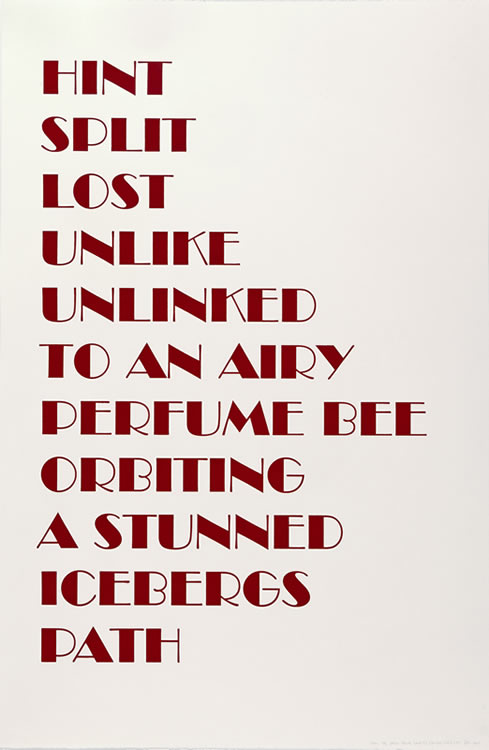 Employing one of the earliest forms of moving-image technology, Macdonald’s stop-motion video is a portrait in absence—depicted through a lifetime of discarded books and an abandoned antique parlor piano found in her neglected living room. Constructed frame-by-frame, with books of various shapes and sizes, the video captures the gradual building and dismantling of a wall that both obscures and reveals the battered piano positioned behind. Through the collapsing of time and space and ongoing cyclical process of construction and disassembling, the film reflects on the vicissitudes of a lifetime packed with experience, human loss, entropy and the transient nature of our existence.
Employing one of the earliest forms of moving-image technology, Macdonald’s stop-motion video is a portrait in absence—depicted through a lifetime of discarded books and an abandoned antique parlor piano found in her neglected living room. Constructed frame-by-frame, with books of various shapes and sizes, the video captures the gradual building and dismantling of a wall that both obscures and reveals the battered piano positioned behind. Through the collapsing of time and space and ongoing cyclical process of construction and disassembling, the film reflects on the vicissitudes of a lifetime packed with experience, human loss, entropy and the transient nature of our existence. WORLD IS WATCHING – MANIFESTO
WORLD IS WATCHING – MANIFESTO